Originally Posted, 11 September 2024 – Defence Tech: Shaping the Future of Global Security
Mounting geopolitical challenges, the rapid deglobalisation of the economy, and the emerging use of technology in defence and national security apparatus are driving a widespread uptick in military and defence expenditures.1 By 2030, it has been projected that global military and defence spending will grow nearly 40% to reach approximately $3.3 trillion, an increasing share of which is likely to go towards artificial intelligence (AI), cybersecurity, and other defence technologies.2 It is anticipated that businesses and solution providers throughout the value chain may be well-positioned to benefit, including major military contractors with specialised knowledge, suppliers of cutting-edge components and hardware, and providers of defence-specific security software. For investors, this secular growth opportunity could offer exposure to a compelling macro trend rooted in innovation.
Key Takeaways
- Since 2020, military spending has accelerated by about 4x to 4.4% Year-over-Year (YoY) Compound Annual Growth Rate (CAGR).3 Growth is expected to remain at these elevated levels through 2030.4
- The defence sector’s projected uptick in software and systems development requires specialised hardware, creating demand for providers of sensors, advanced components, AI chips, and other hardware-based processing, sensing, and networking solutions.
- Cyberspace transcends geographical boundaries, and safeguarding citizen, corporate, and military interests in the digital realm is a focus for countries.
Global Defence Spending Has Continued to Trend Higher
In 2023, global military spending increased for the ninth consecutive year to reach a record $2.44 trillion.5 The United States stood out as the world’s foremost military spender with military expenditures totalling a staggering $916 billion.6 That outlay was 37.5% of total global military spending and three times more than the world’s second-largest spender, China.7 Russia, India, and Saudi Arabia rounded out the top five. Jointly, this group accounted for 63% of the world’s military expenditure.8

A combination of geopolitical tension, deglobalisation, and technological advancements may sustain the upward trajectory in defence spending. Between 2010 and 2020, global military spending grew at an approximate compound annual growth rate (CAGR) of 1%.9 But since 2020, military spending growth has accelerated by roughly 4x to 4.4% YoY CAGR.10 It is anticipated that growth may continue at these elevated levels through 2030, surpassing $3.3 trillion.11
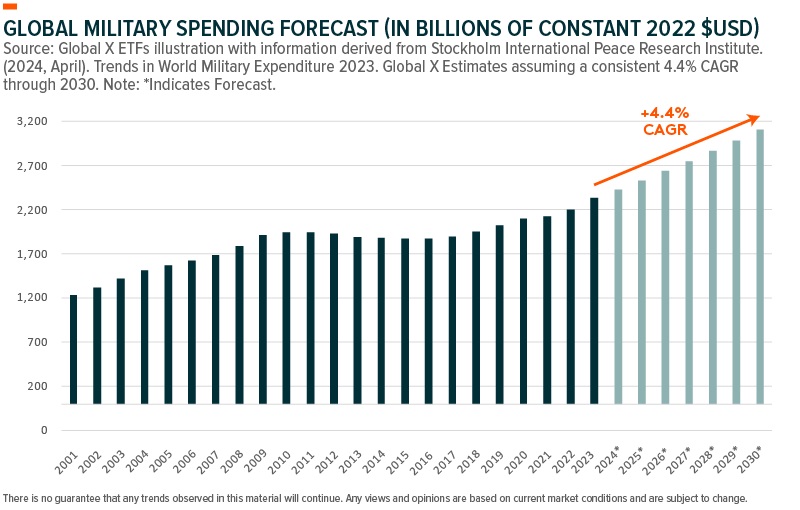
Instability in Eastern Europe appears to be one of the factors driving the recent uptick in spending. The U.S. government has provided more than $107 billion in humanitarian, financial, and military aid to Ukraine since the start of the war with Russia.12 Many other countries, including NATO and European Union members, are also contributing sizeable aid packages to Ukraine.13
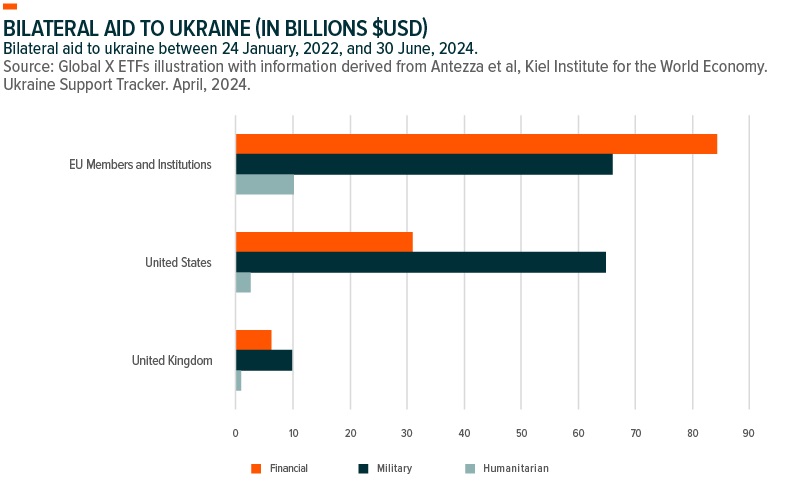
Europe’s military expenditure has reached its highest levels since the Cold War, driven by Russia’s invasion of Ukraine.14 2023 saw a significant 16.4% YoY increase in defence investments.15 The United Kingdom was amongst the top spenders among European nations, ranking sixth globally and contributing 3.0% to the global defence budget, surpassing Germany at 2.6% and France at 2.4%.16 These expenditures are inclusive of contributions aimed at supporting Ukraine.17
Shifting focus outside of the Russia-Ukraine War, China boosted its defence budget for the 2024 by 7.2% YoY reaching $232 billion, despite broad economic weakness.18 Similarly, Taiwan, in response to China’s extensive military exercises, proposed a record-high defence budget of $19.1 billion for 2024, a 7.7% YoY increase, bringing its overall defence spending to approximately 2.5% of GDP.19
Not surprisingly, U.S. investments in military and defence initiatives show no signs of abating. The Biden Administration’s Fiscal Responsibility Act of 2023, adopted a proposed topline of $886 billion for fiscal year 2024 defence spending, a 3.2% increase from FY 2023. $842 billion of that $886 billion is earmarked for the Defence Department.20
Projections from the U.S. Congressional Budget Office suggest that defence spending will reach $1.14 trillion and represent 2.6% of the GDP by 2034.21
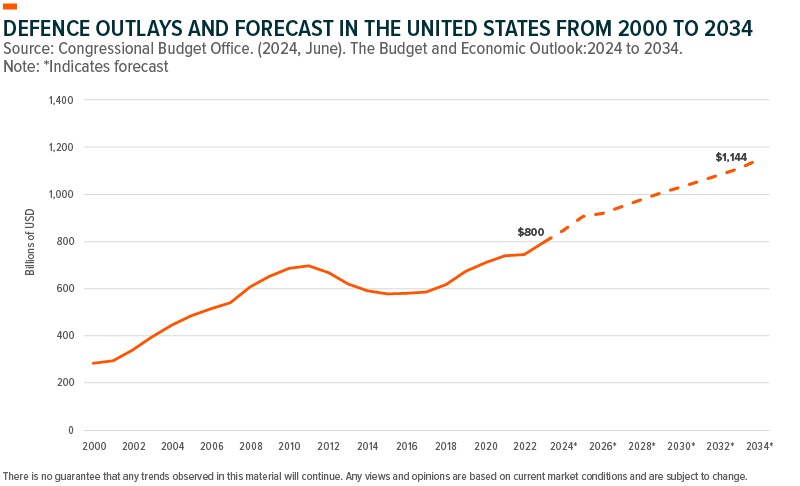
The Digitisation of Defence Is Upon Us
In the past, military spending primarily focused on acquiring conventional hardware and ammunition. Now, the budget allocation landscape is shifting towards digitisation. Emerging military and security technologies, such as artificial intelligence, cybersecurity, and technology convergence, may be regarded as major drivers behind this surge in defence technology spending.
A reliable indicator of a country’s commitment to advancing defence technology is its research and development (R&D) budget. For the United States, the notable increase in R&D over the past decade from 12.8% of its total defence budget allocation in 2013 to 16.8% in 2025, marks a strategic shift for the Department of Defence (DoD).22,23 The DoD’s Fiscal Year (FY) 2025 budget allocates $143.2 billion to R&D, a 10% increase from FY 2023.24 It earmarks $17.2 billion for science and technology initiatives and $1.8 billion to advancing AI capabilities.25
Among the more notable emerging technologies in development are lethal autonomous weapon systems (LAWS). Defined as weapons that autonomously identify, target, and engage adversaries with limited human intervention, LAWS harness the power of high-speed computers, the interconnectedness of the Internet of Things (IoT), and sophisticated big data algorithms. Governments around the world, the United States and China especially, believe that they can secure a competitive military advantage through the development and deployment of LAWS.26
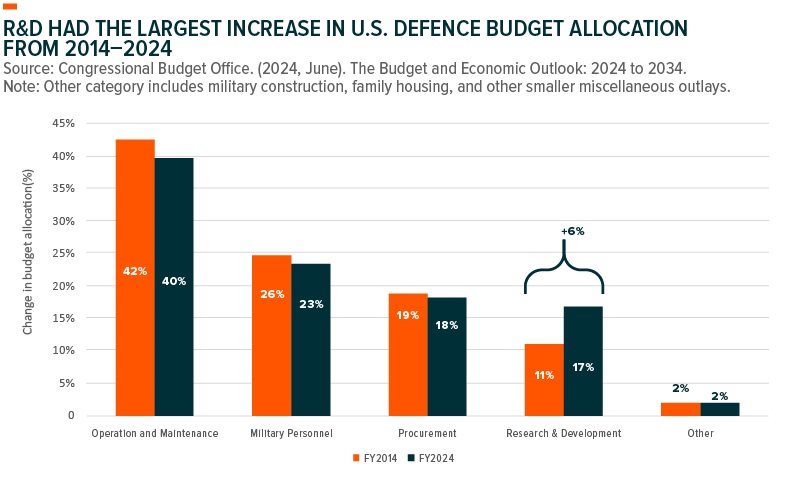
In the growing defence technology market, the software and hardware industries’ presence take on added significance. The global defence information technology (IT) spending market was valued at $79.68 billion in 2020 and is projected to reach $137.65 billion in 2030.27 The defence sector’s uptick in software and systems development requires specialised hardware, creating demand for providers of sensors, advanced components, AI chips, and other hardware-based processing, sensing, and networking solutions.
This uptick could also create opportunities for new partnerships between the public and private sectors, including those that specialise in data analytics and artificial intelligence/machine learning (AI/ML). Looking at the U.S., in May 2024, Palantir secured a significant contract from the Department of Defence’s Chief Digital and Artificial Intelligence Office (CDAO) for its AI-enabled operating system, starting with an initial order of $153 million, potentially extending up to $480 million over five years.28 Additionally, Palantir received a $33 million prototype contract to integrate third-party vendor and government capabilities into the Palantir-operated data environment, supporting Combatant Command digital needs.29
In March 2024, Palantir secured a contract valued at $178.4 million by the Army Contracting Command to develop and deliver the Tactical Intelligence Targeting Access Node (TITAN) ground station system, the Army’s next-generation AI/ML-enabled deep-sensing capability.30 The contract includes the creation of 10 TITAN prototypes, integrating advanced technologies for real-time actionable intelligence and enhanced mission command.31 TITAN will connect to various sensors, reducing sensor-to-shooter timelines and improving the accuracy of long-range precision fires.32
The U.S. government is also collaborating with defence tech companies like General Dynamics and Rheinmetall who are actively involved in replacing the aged U.S. Army’s Bradley Fighting Vehicle using detailed digital designs and prototypes for testing, a project valued at around $45 billion.33 Lockheed Martin has boosted its directed energy weapon for the DoD, scaling its 300 (kilowatt) kW laser to an impressive 500 kW.34 This laser’s accuracy is refined through precise target tracking data from radar and sensors, promoting effective target destruction.35
Cyberspace is the New Battleground
Modern warfare is not restricted to bullets and missiles. Cyberspace transcends geographical boundaries, and safeguarding citizen, corporate, and military interests in the digital realm is a major challenge for countries. Consequently, countries are increasingly exploiting cyber vulnerabilities to achieve and attain military objectives. Organised and criminal hacking is rampant, often causing massive public disruption.36 In May 2021, a hacker group disrupted the computer systems of Colonial Pipeline, an oil pipeline based in Texas that supplies nearly half of the fuel to the East Coast.37 The attack forced the pipeline to halt operations for about five days, leading to shortages of gasoline, diesel, and jet fuel. Cybersecurity companies implementing Zero Trust Architecture and Endpoint Detection and Response solutions could stand to benefit from demand from companies and institutions seeking such solutions.38
Cybersecurity is a vast frontier in comprehensive defence operations. Recent U.S. legislation designed to modernise and secure defence systems, government agencies, and critical infrastructure underscore the commitment required. The Infrastructure Investment and Jobs Act included roughly $1.9 billion in cybersecurity funding for state and local government grants, the electrical grid, and Department of Homeland Security (DHS) cybersecurity research.39
Cybersecurity is a primary concern for the DoD, which divides its cyberspace activities (CA) budget into three portfolios: cybersecurity (requested $7.4B FY25), cyberspace operations (requested $6.4B FY25), and R&D (requested $.6B FY25).40 The requested CA budget for FY 2025 is nearly $14.5 billion, a more than $2 billion increase from FY 2023.41
The DoD has also devised its Software Modernization Strategy, which outlines priority tasks such as accelerating the DoD enterprise cloud environment, establishing a department-wide software factory ecosystem, and transforming processes through digitisation to enable resilience and speed.42 The DoD’s Future Years Defence Plan states that air platforms and platform systems, hypersonic and strategic strikes, air and missile defence systems, and space and space-based systems are among the areas receiving the greatest portion of funding for defence tech innovation through 2027.43
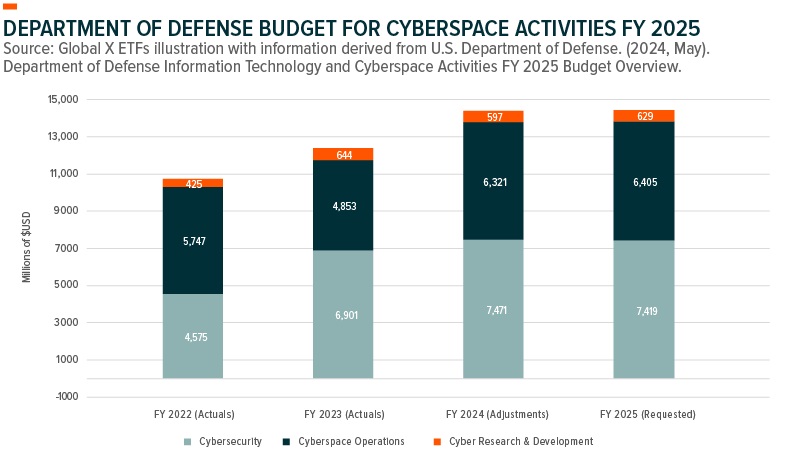
As emerging technologies like AI present new cyber challenges and vulnerabilities, the onus is on governments to devise solutions, which can include diplomacy. For example, in February 2023, at the first ever Responsible Artificial Intelligence in the Military Domain (REAIM) Summit at The Hague, the U.S. State Department proposed the “Political Declaration on Responsible Military Use of Artificial Intelligence and Autonomy,” a plan to ensure that military AI adheres to international humanitarian law and requires each country to establish its own principles for AI-enabled systems.44 Additionally, the proposal mandates that AI capabilities must disengage from the system if they operate unintentionally.45
ARMR LN: An ETF Targeting Innovative Defence Tech
The Global X Defence Tech UCITS ETF (ARMR LN) invests in pureplay defence technology companies that derive 50% or more of their revenues from the sub-categories outlined below. The fund is generally unconstrained by geographical limitations and thus seeks to cast a wide net capturing disruptive defence technology companies. The sub-categories for inclusion involve:
- Cybersecurity: Companies involved in the development and management of defence-related security protocols preventing intrusion and attacks to systems, networks, applications, computers, and/or infrastructure for local and/or national defence applications.
- Defence Technology: Companies involved in the development of artificial intelligence (AI), internet of things (IoT), augmented/virtual reality (AR/VR), human-machine collaboration, big data, specialised 3D light detecting and ranging (LiDAR), geospatial intelligence, and/or security scanning solutions (e.g., biometrics, credential authentication, etc.) for local and/or national defence purposes.
- Advanced Military Systems and Hardware: Companies involved in the development of robotics, drones, advanced weapon systems and military munitions, defence-specific power and fuel systems, sensor arrays, processors and networking equipment, space launch systems (including satellites), radar systems, and/or military aircraft/vehicle production, for local and/or national defence purposes.
Conclusion: Defence Tech May Offer Secular Growth
The global defence industry appears to be an expansive, rapidly growing market with annual spending in the trillions. Escalating geopolitical concerns, the digital transformation of warfare, and the increasing importance of cybersecurity are possible growth drivers. As the world becomes more interconnected, cyberattacks are becoming more frequent and sophisticated, prompting militaries to adopt cutting-edge technologies such as AI, drones, and cyberwarfare capabilities. Their adoption creates a growing market for defence companies and could presents a compelling opportunity for investors seeking exposure to a sector with potential sustained growth. Exposure to the future of the defence industry means exposure to technological innovation and development.
The risks of investing in ARMR LN are Currency Risk, Derivatives Risk, Equities Risk, Concentration Risk, Market Risk, Operational Risk (including safekeeping of assets), Risks associated with the ability to track an index and Liquidity Risk. More details regarding the risks of investing and in this ETF specifically is available in the ‘Risk Factors’ section of the Prospectus.
Global X insights do not take into account a person’s own financial position or circumstances of any person or entity in any region or jurisdiction. This information should not be relied upon as a primary basis for any investment decision. Its applicability will depend on the particular circumstances of each investor. Any views and opinions are based on current market conditions and are subject to change. This information is not intended to be, nor does it constitute, investment research.
This document is not intended to be, or does not constitute, investment research
Join The Conversation
If you have a general question, it may already be covered in our FAQs page. go to: IBKR Ireland FAQs or IBKR U.K. FAQs. If you have an account-specific question or concern, please reach out to Client Services: IBKR Ireland or IBKR U.K..
Leave a Reply
Disclosure: Interactive Brokers Third Party
Information posted on IBKR Campus that is provided by third-parties does NOT constitute a recommendation that you should contract for the services of that third party. Third-party participants who contribute to IBKR Campus are independent of Interactive Brokers and Interactive Brokers does not make any representations or warranties concerning the services offered, their past or future performance, or the accuracy of the information provided by the third party. Past performance is no guarantee of future results.
This material is from Global X ETFs Europe and is being posted with its permission. The views expressed in this material are solely those of the author and/or Global X ETFs Europe and Interactive Brokers is not endorsing or recommending any investment or trading discussed in the material. This material is not and should not be construed as an offer to buy or sell any security. It should not be construed as research or investment advice or a recommendation to buy, sell or hold any security or commodity. This material does not and is not intended to take into account the particular financial conditions, investment objectives or requirements of individual customers. Before acting on this material, you should consider whether it is suitable for your particular circumstances and, as necessary, seek professional advice.
Disclosure: ETFs
Any discussion or mention of an ETF is not to be construed as recommendation, promotion or solicitation. All investors should review and consider associated investment risks, charges and expenses of the investment company or fund prior to investing. Before acting on this material, you should consider whether it is suitable for your particular circumstances and, as necessary, seek professional advice.
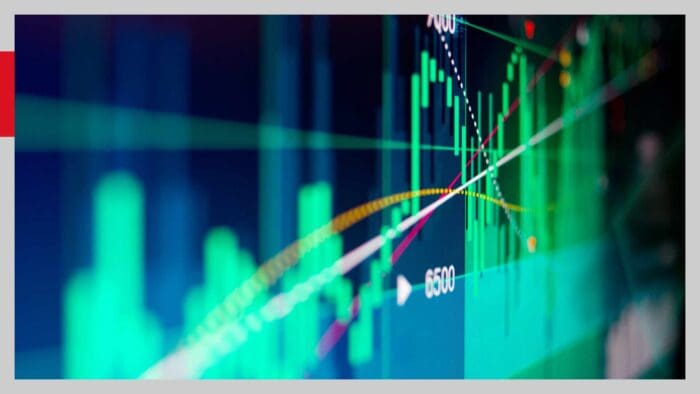
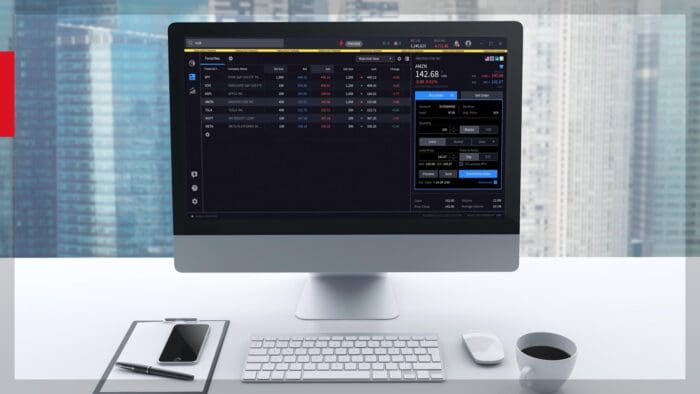



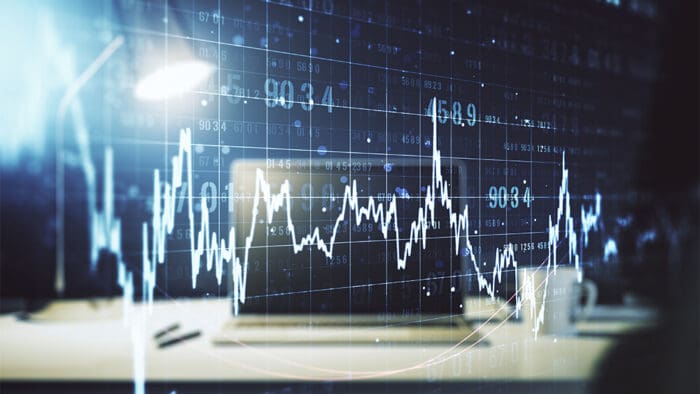
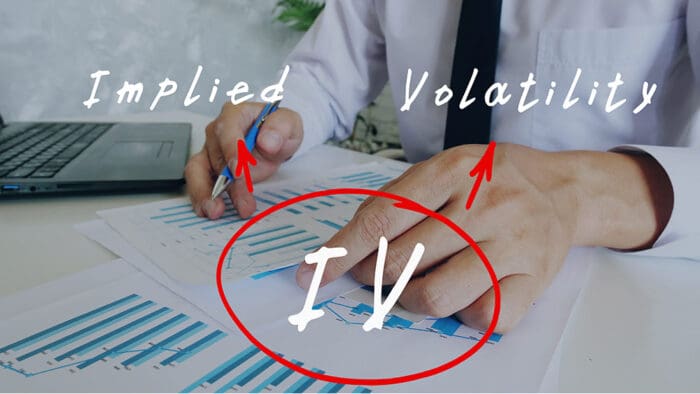








I?m amazed, I have to admit. Rarely do I encounter a blog that?s both equally educative and amusing, and without a doubt, you’ve hit the nail on the head.
The issue is something not enough people are speaking intelligently about.
Now i’m very happy that I found this in my search for something concerning
this.
We hope you continue to Traders’ Insight!
Real excellent info can be found on website.
We hope you continue to enjoy Traders’ Insight!
Howdy very cool website!! Man .. Excellent .. Amazing ..
I will bookmark your web site and take the feeds also?
I am glad to seek out numerous helpful information right here within the post, we need work out extra strategies in this regard, thanks for sharing.
. . . . .
We hope you continue to enjoy Traders’ Insight!
Wow, this piece of writing is nice, my sister is analyzing
these kinds of things, therefore I am going to convey her.
Hi Sunwin, we hope you continue to enjoy Traders’ Insight!
I’d like to thank you for the efforts you have put in penning this website.
I am hoping to check out the same high-grade content from you later on as well.
In fact, your creative writing abilities has motivated me to get my
very own website now 😉
We hope you continue to enjoy Traders’ Insight!
Hello there! This is my first comment here so I just wanted
to give a quick shout out and tell you I truly enjoy reading through your posts.
Can you recommend any other blogs/websites/forums that go over the
same topics? Thank you so much!
We hope you continue to enjoy Traders’ Academy!
Hey just wanted to give you a quick heads up.
The text in your post seem to be running off the screen in Ie.
I’m not sure if this is a formatting issue or something to
do with browser compatibility but I figured I’d post to let you know.
The design and style look great though! Hope you get the issue solved soon. Many thanks
Thank you for contacting us on IBKR Campus. Could you please share what device you are using? We will attempt to replicate the issue. We would appreciate the opportunity to turn around your experience!
Excellent pieces. Keep posting such kind of information on your page.
Im really impressed by your site.
Hello there, You’ve performed an excellent job.
I will certainly digg it and individually recommend to my friends.
I am confident they’ll be benefited from this site.
Thanks for engaging! Nothing makes us happier than satisfied readers!
We still cannot quite believe that I could end up being one
of those studying the important guidelines found on your website.
My family and I are really thankful for the generosity and for offering me
the possibility to pursue the chosen profession path. Appreciate your sharing the important information I
got from your site.
We appreciate your kind words!
Marvelous, what a blog it is! This webpage gives useful facts to
us, keep it up.
We appreciate your kind words!
Perfectly pent subject matter, thanks for information.
Thanks for engaging!
Howdy! I could have sworn I?ve been to your blog before but after browsing through some of the posts I
realized it?s new to me. Anyways, I?m certainly happy I found it and I?ll be bookmarking
it and checking back regularly!
Thanks for engaging! We appreciate your positive comments!
This is the perfect webpage for anyone who really wants
to understand this topic. You realize a whole lot
its almost tough to argue with you (not that I really would want to?HaHa).
You certainly put a brand new spin on a topic which has been discussed for years.
Wonderful stuff, just wonderful!
We hope you continue to enjoy Traders’ Insight!
Good way of explaining, and fastidious piece of writing to obtain data on the topic of my presentation focus, which
i am going to deliver in institution of higher education.
Thanks for engaging! We appreciate your positive comments!
The next time I read a blog, Hopefully it doesn’t fail me just as much as this one.
I mean, I know it was my choice to read through, but I genuinely thought you would probably have something interesting to say.
All I hear is a bunch of crying about something that
you could fix if you were not too busy searching for attention.
Thank you for reaching out, and we are sorry to hear that. If you have any specific suggestions or feedback, we would love to hear them!